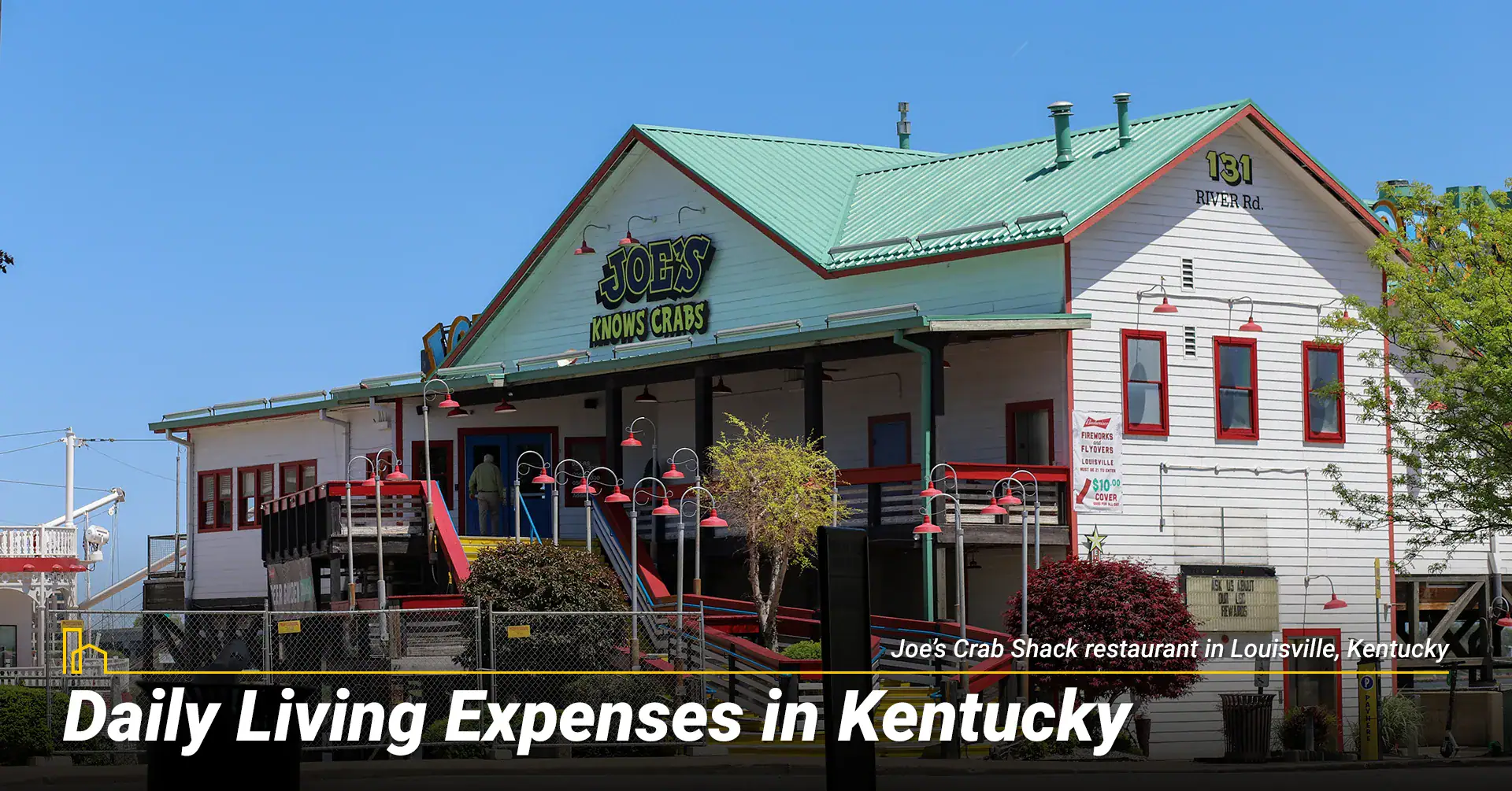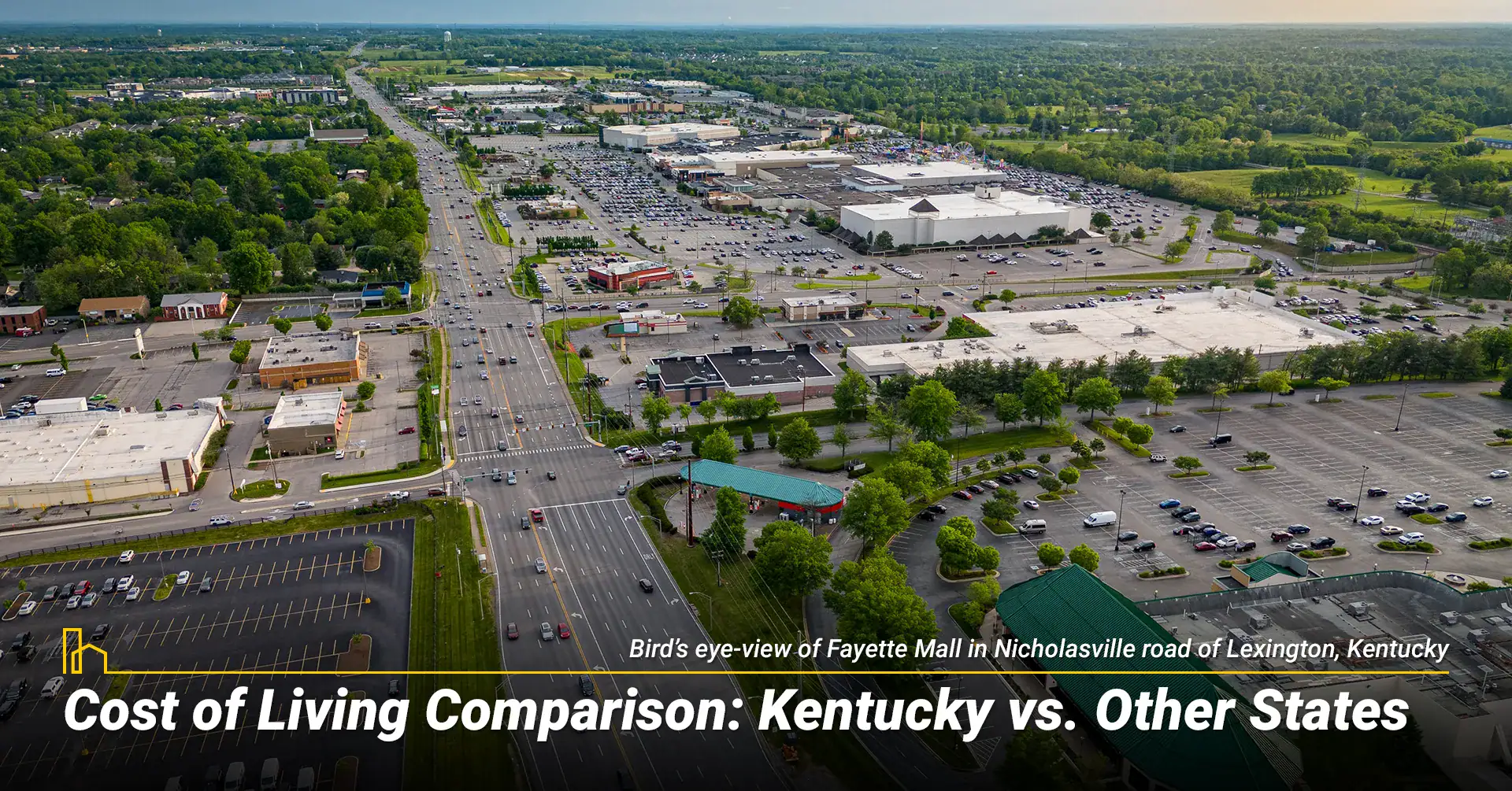Living in Kentucky
Local Editor(s)

Table of Contents:
- The Complete Guide to Cost of Living and Lifestyle
- 1. Kentucky Housing Costs: Affordable Options Statewide
- 2. Kentucky Tax Structure: No State Income Tax Advantage
- 3. Daily Living Expenses in Kentucky
- 4. Family Life in Kentucky: Excellent Educational Opportunities
- 5. Kentucky Transportation: Car-Friendly Infrastructure
- 6. Kentucky Job Market and Income Potential
- 7. Cost of Living Comparison: Kentucky vs. Other States
- 8. Kentucky Lifestyle: Year-Round Opportunities
- 9. Best Places to Live in Kentucky for Different Needs
- Frequently Asked Questions About Living in Kentucky
The Complete Guide to Cost of Living and Lifestyle
Kentucky living offers exceptional value with a low cost of living and no state income tax, diverse job opportunities, and a climate that features four distinct seasons. The Bluegrass State attracts everyone from young professionals to retirees seeking affordability and a high quality of life. This comprehensive guide covers housing prices, taxes, daily expenses, and lifestyle factors to help you decide if the Bluegrass State is your new home.
1. Kentucky Housing Costs: Affordable Options Statewide

Kentucky real estate provides broad housing options from urban condos to rural ranch-style homes at prices significantly below national averages. Understanding Kentucky housing market trends will help you find excellent value across diverse communities.
A. Major Kentucky Cities Housing Costs
City | HOMEiA Score | Median Home Price | Avg. Rent (2-Bedroom) | Notes |
|---|---|---|---|---|
| Bowling Green | 85/100 | ~$269,000 | $950 – $1,100 | Rapid growth due to manufacturing and WKU. |
| Owensboro | 87/100 | ~$195,000 | $850 – $1,000 | Exceptional riverfront value. |
| Lexington | 88/100 | ~$295,000 | $1,150 – $1,400 | Strong demand from university and horse industries. |
| Louisville | 89/100 | ~$265,000 | $1,100 – $1,300 | Diverse market from urban lofts to suburbs. |
| Covington | 91/100 | ~$240,000 | $1,000 – $1,200 | Proximity to Cincinnati increases prices. |
B. Kentucky Housing Strategies and Financial Options
Kentucky offers excellent financing options including widely accepted FHA loans (great for first-time homebuyers) and VA loans, providing lower down payments for qualified buyers. The Kentucky Homestead Exemption also reduces property taxes for owner-occupants, creating annual savings.
Smart buyers explore down payment assistance programs through local municipalities. Consider areas just outside major metros for better value while maintaining reasonable commute access. Kentucky’s annual population growth drives consistent housing demand, making strategic location choices crucial for both affordability and future property value.
Moving to Kentucky: The Complete Relocation Guide & Checklist
Kentucky combines urban convenience with rural charm, attracting 4.5 million residents nationwide. Louisville and Lexington offer culture and careers, while scenic small towns with horse farms and wooded hills create a welcoming, affordable lifestyle that blends vibrant city life with the timeless appeal of the Bluegrass State’s rolling landscapes…
2. Kentucky Tax Structure: No State Income Tax Advantage

A. Kentucky State Taxes Overview
Kentucky is transitioning to a flat income tax, allowing residents to keep more of their earnings, though this advantage is partially offset by other taxes.
For a household earning $150,000 annually, the tax savings compared to high-tax states could exceed $10,000 per year, significantly impacting disposable income. Sales tax averages 6 percent statewide, and Kentucky does not tax groceries, prescription medications, or most services, keeping essential costs manageable. The combination of property tax rates below the national average, having no income tax, and typically lower home values increases the state’s affordability.
B. Tax Comparison: Kentucky vs. Other States
Tax Type | Kentucky | Tennessee | Ohio | National Avg. |
|---|---|---|---|---|
| Income Tax | Flat rate | 0% | Progressive | ~5.1% |
| Sales Tax | 6% | 7% | 5.75% | ~6.35% |
| Property Tax | 0.86% | 0.71% | 1.57% | 1.07% |
3. Daily Living Expenses in Kentucky

Kentucky living expenses typically run 10-12 percent below national averages, making daily costs manageable across most income levels. For a different perspective, you can read about the cost of living in Florida vs. Texas.
A. Monthly Living Costs Breakdown
Expense Category | Kentucky Cost | National Comparison |
|---|---|---|
| Groceries (per person) | $275-$350/month | 8% below average |
| Utilities | $160-$220/month | Slightly above average |
| Gasoline | ~$3.20/gallon | 5-10% below average |
| Healthcare (individual) | $400-$450/month | Competitive rates |
| Dining Out | Varies by city | Below national city rates |
B. Cost-Saving Strategies for Kentucky Living
Smart Kentucky residents use competitive electricity markets to shop for better utility rates, potentially saving 15-20 percent. Many providers offer fixed-rate plans that protect against seasonal price fluctuations.
Grocery costs vary significantly by location, with Kentucky-based chains like Kroger and regional favorites like Food City often providing better prices. Warehouse clubs and farmers markets offer additional savings opportunities for budget-conscious families.
The Pros and Cons of Living in Kentucky
Whether you’re looking for exciting city life, suburbs to raise a family, or a little R&R in the countryside, Kentucky has something to offer everyone. It’s an affordable, friendly place with beautiful scenery, picturesque bourbon distilleries, and historical sites…
4. Family Life in Kentucky: Excellent Educational Opportunities

Kentucky offers outstanding family life with quality school districts, affordable childcare, and extensive recreational opportunities.
A. Education Excellence in Kentucky
Top-ranked school districts including those in Oldham County, Boone County, and Fayette County (Lexington) consistently rank among the state’s best. These districts benefit from property tax revenues funding advanced STEM programs, arts education, and extracurricular activities.
Kentucky maintains a strong university system with the University of Kentucky and University of Louisville providing world-class higher education at affordable in-state tuition rates. Community colleges offer excellent transfer programs and technical training aligned with Kentucky’s growing industries.
B. Childcare and Family Costs
Family Expense | Kentucky Cost | Available Support |
|---|---|---|
| Childcare | $800-$1,200/month | State assistance programs |
| Summer Programs | Varies by district | Community-sponsored options |
| Youth Sports | $100-$400/season | Extensive league systems |
| After-school Care | $200-$500/month | School and private options |
Kentucky features over 45 state parks and natural sites providing affordable family recreation opportunities year-round.
5. Kentucky Transportation: Car-Friendly Infrastructure

Transportation in Kentucky centers around personal vehicles with expanding public transit options in major metropolitan areas.
A. Vehicle-Related Expenses
Transportation Cost | Kentucky Average | National Comparison |
|---|---|---|
| Auto Insurance | $1,300-$1,600/year | Competitive rates |
| Gas Prices | ~$3.20/gallon | Below national average |
| Vehicle Registration | $21-$30 annually | Below most states |
| Maintenance | Standard rates | Competitive service costs |
B. Public Transit Options
Metro Area | Transit System | Monthly Pass | Coverage Area |
|---|---|---|---|
| Louisville | TARC | $50 | Extensive urban coverage |
| Lexington | Lextran | $30 | Good urban coverage |
| Northern KY | TANK | $60 | Connects to Cincinnati |
While Kentucky cities are traditionally car-dependent, public transit infrastructure continues expanding in urban areas. Typical commute times range from 22-28 minutes, reasonable for major metropolitan regions but requiring strategic location choices.
Recommended for you
6. Kentucky Job Market and Income Potential

Kentucky maintains a diverse economy with competitive wages across multiple industries. For those considering other states, the job market in Ohio might offer interesting comparisons.
A. Income Statistics and Employment
Income Metric | Kentucky | National Average |
|---|---|---|
| Minimum Wage | $7.25/hour | $7.25/hour |
| Median Household Income | $55,000 | $70,000 |
| Unemployment Rate | ~4.2% | ~3.9% |
| Job Growth Rate | Steady | Varies |
B. Major Kentucky Employers and Industries
Industry | Key Companies | Typical Salary Range |
|---|---|---|
| Healthcare | Norton Healthcare, Baptist Health | $45,000-$120,000/year |
| Manufacturing | Toyota, Ford, GE Appliances, Corvette (GM) | $40,000-$85,000/year |
| Logistics | UPS, Amazon | $35,000-$75,000/year |
| Education | University of Kentucky, Jefferson Country Public Schools (JCPS) | $35,000-$100,000/year |
Kentucky’s economy demonstrates remarkable diversity that provides stability during economic fluctuations. The manufacturing sector remains strong while healthcare represents one of Kentucky’s fastest-growing employment sectors.
The 10 Best Places to Live in Kentucky for Families
Kentucky, located in the heart of the American South, might not be the first state that springs to mind when you’re considering a move to a family-friendly location, but the truth is that Kentucky has many features and characteristics that make it ideal for families…
7. Cost of Living Comparison: Kentucky vs. Other States

Kentucky offers excellent value compared to other popular destinations, particularly when compared to high-cost states.
Expense Category | Kentucky | Tennessee | Ohio | National Avg. |
|---|---|---|---|---|
| Median Home Price | $235,000 | $320,000 | $200,000 | $357,000 |
| Rent (2-Bedroom) | $950 | $1,200 | $900 | $1,300 |
| Gas Price/Gallon | $3.20 | $3.10 | $3.35 | $3.60 |
| Utilities (Monthly) | $190 | $180 | $200 | $210 |
8. Kentucky Lifestyle: Year-Round Opportunities

Kentucky lifestyle combines affordability with cultural diversity, reasonable job markets, and year-round outdoor activities. These benefits are balanced against humid summers and car dependency.
A. Lifestyle Advantages of Kentucky Living
Kentucky offers no state income tax, allowing residents to redirect thousands of dollars annually toward home ownership, retirement savings, or family activities. This financial advantage becomes particularly significant for middle-income earners.
The state features rich cultural diversity with vibrant communities throughout major cities. The state’s business-friendly environment encourages entrepreneurship while year-round weather enables outdoor recreation and active lifestyles.
B. Kentucky Living Challenges
Hot, humid summers require significant air conditioning costs from June through September. Electricity bills can increase 50-75 percent during summer peaks, with some residents paying $250-400 monthly for cooling.
High sales taxes on certain items can offset some savings from no income tax. Car dependency makes vehicle ownership essential for daily activities, requiring multiple vehicles for most families. This vehicle reliance increases transportation costs through vehicle payments, insurance, fuel, and maintenance.
5 Best Places to Live in Kentucky
Kentucky blends urban amenities with natural beauty and tradition. This guide provides data-driven analysis of the best places to live in Kentucky, evaluating economic opportunity, affordability, safety, and education. From vibrant Louisville to historic Lexington, discover premier destinations for your future…
9. Best Places to Live in Kentucky for Different Needs

A. Family-Friendly Kentucky Communities
Community Type | Best Cities | HOMEiA Score | Median Home Price | Key Benefits |
|---|---|---|---|---|
| Suburban Family | Fort Mitchell | 91/100 | $300,000-$400,000 | Top schools, safety |
| Affordable Family | Owensboro | 87/100 | $195,000-$270,000 | Lower costs, good schools |
| Urban Family | Lexington | 88/100 | $265,000-$295,000 | Job opportunities, culture |
B. Professional and Retiree Options
Bowling Green (85) provides strong opportunities in manufacturing, education, and healthcare with its growing economy. Owensboro (87) combines affordability with excellent healthcare access and family-friendly amenities. Lexington (88) offers opportunities in healthcare, education, and technology with its vibrant arts scene, and Louisville (89) features diverse corporate headquarters and world-class cultural attractions.
Conclusion: Making Kentucky Living Work for You
Kentucky cost of living is approximately 10-12 percent lower than the national average, with housing costs about 15-20 percent below average, making the state attractive for families, professionals, and retirees seeking value. The combination of a transitioning flat income tax, diverse job opportunities, and four-season climate creates compelling reasons to choose Kentucky.
Success in Kentucky depends on choosing the right location for your budget and lifestyle preferences, preparing for humid summers and associated cooling costs, and embracing the car-centric transportation culture. With proper planning and realistic expectations about regional differences, Kentucky living offers both financial advantages and quality of life benefits.
Whether you’re drawn by Louisville’s urban energy, Lexington’s horse country elegance, or simply the appeal of keeping more of your paycheck, Kentucky provides diverse opportunities for building a successful life in the Bluegrass State.
Frequently Asked Questions About Living in Kentucky
1. What is the average cost of living in Kentucky compared to the national average?
Kentucky’s cost of living is approximately 10-12 percent lower than the national average overall, with housing costs about 15-20 percent below average. This makes Kentucky attractive for families and professionals seeking affordability without sacrificing quality of life.
2. How much income is needed to live comfortably in Kentucky?
A single adult needs roughly $45,000-$50,000 annually to live comfortably in Kentucky, while a family of four requires approximately $75,000-$85,000 per year. Costs vary significantly between major metros like Lexington and smaller cities like Owensboro.
3. Which Kentucky city is most affordable for families and retirees?
Owensboro consistently ranks as one of Kentucky’s most affordable cities, offering low housing costs, good healthcare access, and family-friendly amenities. Smaller cities like Paducah and Morehead provide even lower costs with a more relaxed pace of life.
4. How does Kentucky compare to other no-tax states?
Kentucky holds slightly higher overall costs than Tennessee but provides more diverse geography and a four-season climate. Compared to Florida, Kentucky has much lower housing costs but doesn’t offer beach access. Each state provides excellent options depending on lifestyle preferences.
5. What are the biggest monthly expenses for Kentucky residents?
Housing, utilities, and transportation typically represent the largest monthly expenses. Air conditioning costs during humid summers can significantly increase utility bills, particularly from June through September. Vehicle-related expenses are also substantial due to necessary car ownership.
6. Is Kentucky good for first-time homebuyers?
Yes, with a median home price of $235,000 and numerous buyer assistance programs. FHA and VA loans are widely accepted, and the Kentucky Homestead Exemption provides ongoing property tax relief for owner-occupants.
7. How do gas and grocery costs compare nationally?
Gas averages $3.20 per gallon, consistently below national averages. Groceries run about 8 percent below the US average, though costs vary significantly between urban and rural areas throughout the state.
8. What should I know about healthcare costs in Kentucky?
Healthcare premiums average $400-$450 monthly for individuals, with annual per-person costs around $7,200. Kentucky offers competitive healthcare options, particularly in major metropolitan areas with renowned medical centers.
9. What lifestyle advantages does Kentucky offer residents?
Kentucky provides a flat income tax, affordable housing options, year-round outdoor recreation, diverse cultural communities, reasonable job markets, and the freedom to enjoy a larger home and higher quality of life compared to other states.
Local Editor(s)
Moving to Kentucky: The Complete Relocation Guide & Checklist
Nestled between the Ohio River and Appalachian foothills, Kentucky offers an attractive blend of urban convenience and rural charm that draws newcomers nationwide. About 4.5 million residents call the Bluegrass…
5 Best Places to Live in Kentucky
Kentucky is a state of captivating contrasts, where world-class urban amenities meet unparalleled natural beauty and deep-rooted tradition. Choosing the right city within the Bluegrass State is key to unlocking…
The Pros and Cons of Living in Kentucky
When you think of Kentucky, you might conjure up images of fried chicken, bourbon, and horse racing. While you will find no shortage of those things in the Bluegrass State,…
The 10 Best Places to Live in Kentucky for Families
If you’re looking to relocate your family, you’re likely on the lookout for a place that has the right set of values, opportunities, and amenities to keep all the members…
30 Best Packing Tips for Moving to a New City
The mission is simple: move everything you own from your current home to your new one. The actual process? Long, stressful and headache-inducing. The pressure is multiplied when you’re moving…
An Ultimate Guide to Moving for Home Buyers and Sellers
The real estate is a booming industry which makes it easy for anyone to earn and mold their professional careers. With perseverance and patience, a career in real estate will…
15 Essential Steps for Moving to a New City
Moving across town to a new home or apartment is hard enough. You’ll be packing, cleaning, lugging things back and forth, and running here and there to sign agreements or…

 Considering
Considering
























